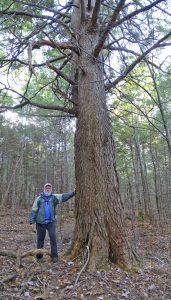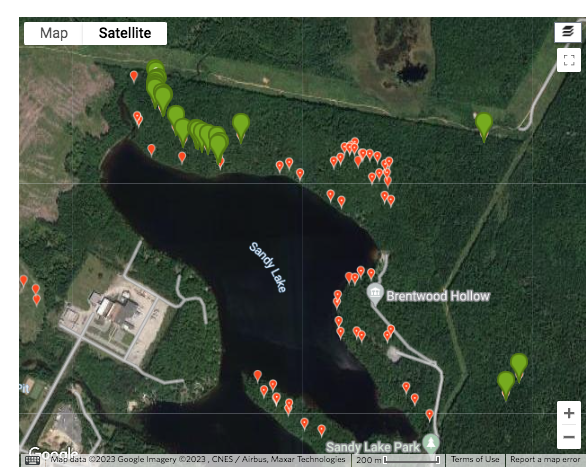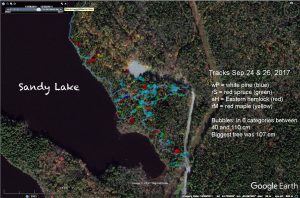I routinely record all “Big Trees” that are ‘readily visible’ from my walking routes, sometimes changing the route to get a better view or to explore an area of big trees seen in the distance. I have estimated the field of vision as approximately 12 m from the walking route for more closed stands, and 20 to 30 m for more open stands.
“Big Trees” are taken to be those those of 20″ (50 cm) diameter at breast height (dbh) and larger, but in 2017 and 2018, I recorded any tree 16″ (40.6cm) and larger. In 2019, I restricted the records to trees 19″ and greater.
If I am recording a lot of trees, I typically make a visual estimate of diameter followed by a measurement of the circumference for about 1/4 of them, and calculate the diameter (dbh=circumference/pi) for those trees accordingly. For others, the diameters are estimated from visual observations alone. The process of making the estimates and actually measuring diameters helps mentally to ‘calibate’ the visual estimates. Comparison of the measured and estimated values indicates very good agreement for averages (within 1″) but, as could be expected, estimates for individual trees are more variable, e.g. by 1-3″ for a tree 2 ft in diameter. When I post records on iNaturalist (see below), I report both the measured and estimated values for trees that I actually measure.

An example of the kind of results that can be generated from such data is shown in the modified Google map above with different colours and sizes of bubbles showing locations, species and sizes of trees. (I plan to make such maps for all of my tracks.)
One use I have made of these data is to identify stands where there is a concentration of big trees, e.g. view Google map of White Pine OG site, some of which were formally assessed for Old Forest ratings.
Big Trees of Sandy Lake & Environs on iNaturalist
In 2019, I began posting species observations on iNaturalist and created a separate Project for ‘Big Trees’- view Big Trees of Sandy Lake & Environs

Big Trees in the area of Sandy Lake as recorded and uploaded to iNaturalist by Apr 12, 2023. (Many more observations still to be uploaded)
This is a much more convenient method of collating info on Big Trees than the bubble plots above (although those convey more detailed info), also the data are publicly accessible and permanent, so I will be posting all of my Big Tree observations under this Project on iNaturalist. ‘Just beginning to do that in Sep 2019.
It is restricted to trees of 19″ and larger. One record is an observation of a single tree on a single date. The species is identified, dbh (diameter at breast height) given, and for most, a photo(s) of the leaves/branches is added (for ID), sometimes other photos to illustrate the habitat. I expect it will take me until the spring of 2020 to enter all of my Big Tree observations to date. Update Apr 19, 2023: Still ongoing!!.
Healthy Hemlock Forests of the Maritimes (iNaturalist Project)
Any “Big Tree” observations on hemlock are also entered in this Project which was created by Matthew Smith, an ecologist for Kejimkujik National Park. From his ‘About’ description:
This project will track the location of hemlock stands throughout the Maritimes. Eastern Hemlock forests are endangered due to the presence of a sucking insect Hemlock Woolly Adelgid (HWA). In July 2017, HWA was observed in 5 counties (Yarmouth, Digby, Shelburne, Queens and Annapolis) in Southern Nova Scotia. This site will allow observers to submit reports of HWA and infestation level.
Please report any sightings to CFIA: www.inspection.gc.ca/pests
To learn more about Hemlock Woolly Adelgid see: http://www.inspection.gc.ca/plants/plant-pests-invasive-species/insects/hemlock-woolly-adelgid/fact-sheet/eng/1325616708296/1325618964954 less ↑

